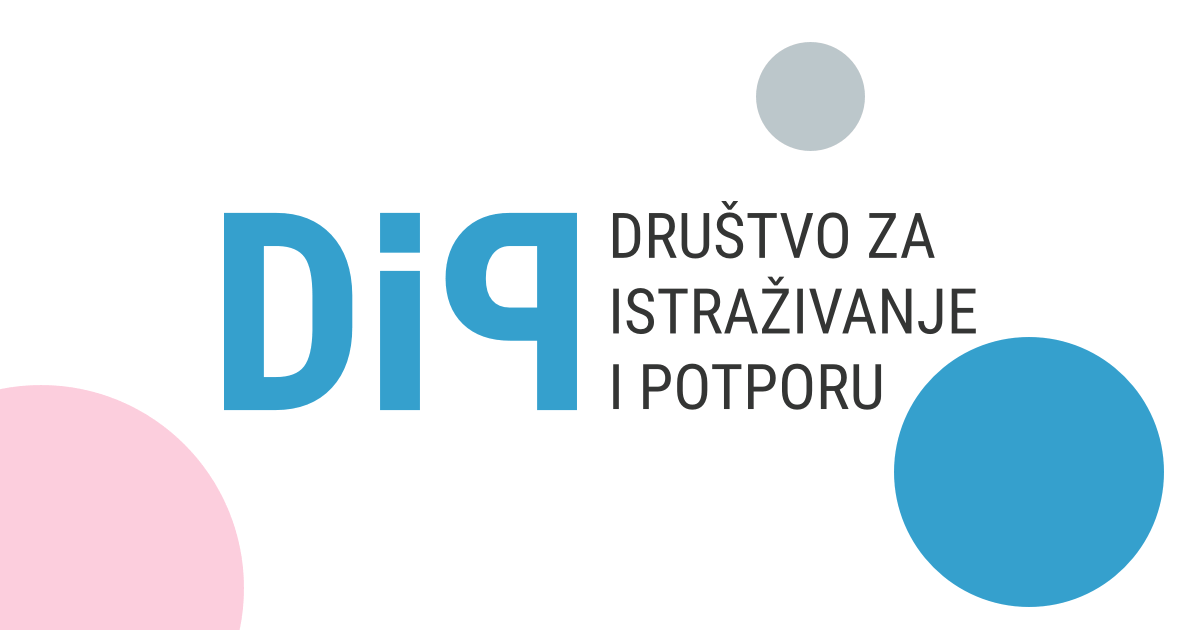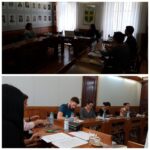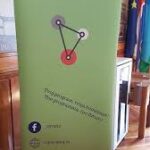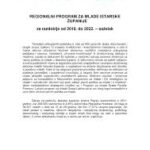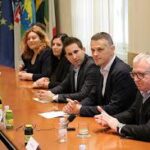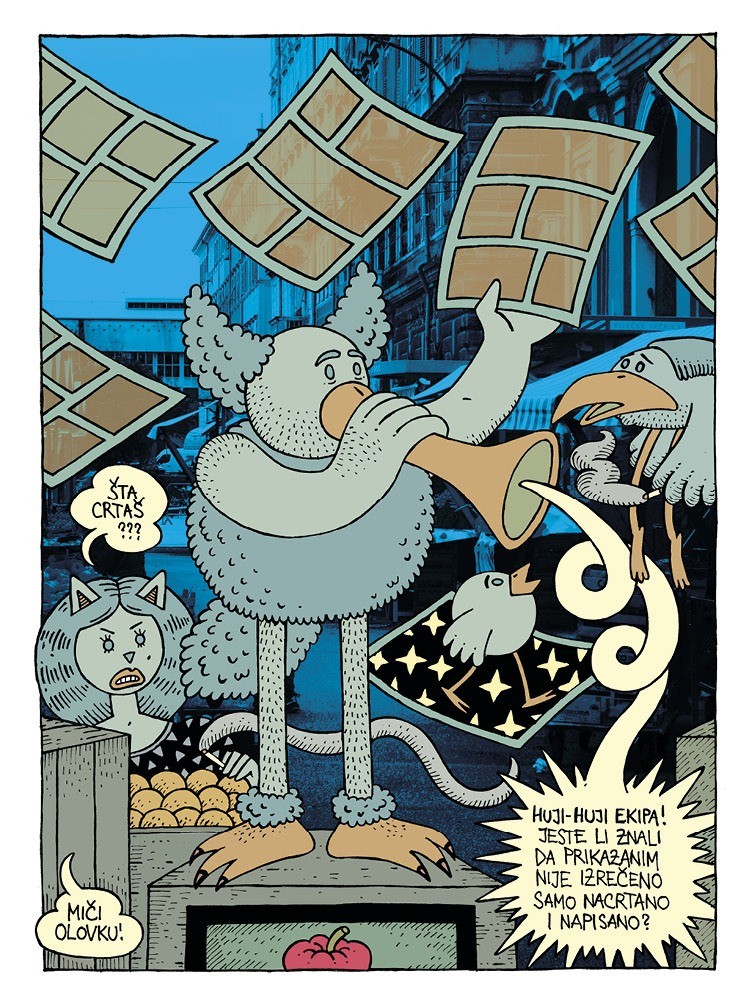Strategies and public policies for young people – development of the Youth Program of the Primorsko-goranska County, from 2020 to 2022
Youth programs are strategies or strategic plans that guarantee young people that decision makers will invest in them. Creating a program for young people is a process during which we get closer to them, in order to find the best measures for improving their lives, and it is a mosaic of professional knowledge and active participation of young people in deciding on subjects that concern them. Our program manager has created several manuals for young people with exactly these topics, and we have a lot of experience in planning, creating and implementing various programs for young people. Some of the manuals that our manager wrote immediately after the completed projects for young people, are:
Priručnik za mlade. Mladi u zajednici bez barijera or nekaselokalniglasovicuju2015.finalezaweb
As part of this program, we have been present for years in the creation of strategies for young people, for which we create a methodology, conduct public forums, analyze data on young people (desk research), carry out research, but also propose (write) the text of the strategy itself, as a result of our research and analysis of youth needs and structured dialogue with decision makers and key stakeholders. Thus, for local and regional self-government units, we created several programs for young people, while we participated in the creation of several ones representing different groups of young people.
Currently, a national program for young people is being developed, which we have been waiting for, for several years: https://esavjetovanja.gov.hr/ECon/MainScreen?entityId=13290, so making this program was even more challenging.
The goals of its development are aligned with the 11 goals of the EU Youth Strategy from 2019 to 2027:
Connecting the EU with the Youth
Equality of All Genders
Inclusive Societies – inclusive societies
Information & Constructive Dialogue – information/being informed and constructive dialogue
Mental Health & Wellbeing – mental health and well-being of young people
Moving Rural Youth Forward – improving the lives of young people in rural areas
Quality Employment for All – quality employment for all
Quality Learning – quality learning
Space and Participation for All – space and participation for all
Sustainable Green Europe – Sustainable Green EU/Croatia
Youth Organizations & European Programs – EU programs with young people – youth organizations and for young people and programs for young people.
We, the “DIP” team, had the honor of creating the program for the youth of the Primorsko-goranska County. After applying for the public procurement, we were selected as the best bidder, so the development and preparations for the development of the program for the youth of PGC immediately began. The direct team that creates the program according to the tried-and-tested, but adapted structure of young people in PGC, includes:
Bernard Šešo, psych. – employee at the DIP, head of data analysis, youth workshops and more
Sanja Crnković – DIP member, head of statistical data collection, graphic processing, etc.
Marta Berčić, prof.soc. – project manager, employee at the DIP.
Karmen Vučetič, psych. – employee at the DIP, data analysis.
The authors of the text of the Program for Youth PGC are Marta Berčić and Bernard Šešo.
Young people, members of the Youth Council of PGC, who initiated the development of the program, and the PGC, were directly involved in the development, and during the development we included volunteers, key stakeholders (associations, institutions and other organizations that have youth programs in their programs. We also included young people from various forms of youth activity and other young people who want to contribute to improving their own position.
We presented the production schedule to the clients and started production in the midst of the corona virus pandemic. The creation took place in stages, and we started the first one in September 29th, 2020:
- Collection of socio-demographic data on young people (end of September 2020).
- Preparation for the communication campaign:
- meetings with SM PGC: September 30th, meeting with SM PGC; October 2nd, 2020, presentation of the program at the Coordination of SM from PGC (Marčelji)
- media appearances – continuous (See: https://dip.hr/program-za-mlade/). Adaptation of the interview protocol with organized forms of youth activity (associations) (beginning of October 2020)
- Creation and adaptation of forms for creating budgets for youth: referral to all LGUs (beginning of October 2020)
- Communication with JLS and SM (continuous)
- Field work – tour of LGUs to inform young people and start implementation and announcement of events:
- Municipality of Lopar and City of Rab, October 8th, 2020.
- First cycle of structured dialogue with young people (open method of coordination in the youth field) workshops/public forums, working groups
- Second cycle of structured dialogue with young people – analysis of achieved opportunities, solutions and advantages for all units (cities and municipalities)
- Third cycle of structured dialogue with young people – suggestions, criticisms and analysis of proposed measures and monitoring indicators
- Public consultation of the interested public
- Acceptance at the PGC Assembly
- Development of action plans
We immediately sent invitations to young people to respond to active participation in the creation of the program.
“If you are a person who works for young people or are a young person, contact us! Do you need support in advocating the interests of young people or how to negotiate with decision makers, how to create a youth council work program, how to create an action plan from a youth program/strategy, if you need any advice on employment, choosing a school and studies; if you don’t know what to do… let us know! We have a lot of experience in that area.”
________________________________________________________________________________________________
Below is a chronological series of steps we took in order to create a program for young PGC students, in the midst of a pandemic. The steps are presented in reverse chronological order, from completion to first steps. This is how we achieve transparency, so the interested public can follow and evaluate all the steps in the creation of this normative act, which was adopted by the PGC assembly.
February 2022 – After the county assembly approved the PGC Youth Program for 2022 on January 17th, the development of an action plan for 2022 starts, as well as the creation of instruments for monitoring the implementation of the Youth Program.
During February we:
- presented the PGC Youth Program to the new convocation of the PGC Youth Council and started informing them about the importance of their involvement in the implementation of the program
- started creating a questionnaire form for monitoring the implementation.
January 2022 – The PGC Assembly will discuss the PGC Youth Program at the end of January. After its adoption, the Action Plan for the implementation of the Program for 2022 will be drawn up.
October 2021 – Soon, we expect a consultation with the relevant public regarding the Youth Program of the PGC. Follow the pages of the PGC: https://www.pgz.hr/dokumenti/savjetovanja-s-javnoscu/ or https://www.pgz.hr/ustroj/skupstina/zupanijski-savjet-mladih/
The program for the youth, based on the analytical basis and the results of the involvement of key stakeholders and young people, is focused on 3 developmental directions of public policies for youth. The complete text, as well as the development directions, will be available on the website at the moment when the public consultation is published. This is an opportunity for you to point out to us some objective and proven facts regarding the young people, that we may have missed. Don’t forget to think of the young people and their needs in your communities.
Below are the materials we discussed, a reminder of what it was like before your interventions, which we took into account in the proposal of the Draft Program for Youth PGC. The full text will be available soon.
Social inclusion, well-being and health of young people-1
Form for public forum – Quality education, learning and youth employment-1
Form for public forum – Inclusion, connection and empowerment of young people-1
2020/2021 Creation of the Program for the Youth of the Primorsko-goranska County:
At the end of February, according to the contract with PGC, we delivered a draft of the PGC Youth Program. The youth program was sent for reading to the relevant administrative departments of the PGC, and to the president of the YC PGC, with whom a meeting was held to agree on the remarks. After considering the comments and corrections of the draft of the Youth Program, the draft of the Program will refer to a public consultation with the interested public, which will be published on the PGC website, and all key stakeholders will be notified in time.
January and February 2021 We invite young people to join the discussion. The first draft of the material is available until the end of the program.
The invitation to participate in public forums was sent to all LGUs, the County, all associations that have actively participated so far, educational institutions, Social Welfare Centers in the area of PGC, the Chamber of Crafts, the Chamber of Commerce, the University of Rijeka and other key stakeholders.
The invitation was published on our Facebook pages and on the PGC website:
https://www.pgz.hr/objave/javni-forumi-za-mlade-izrada-programa-za-mlade-primorsko-goranske-zupanije/
The invitation was also published on the website of the University of Rijeka, and on the website and Facebook page of the Student Union of Rijeka.
https://uniri.hr/vijesti/sudjelujte-u-javnim-forumima-o-izradi-plana-za-mlade-pgz-a/
https://sz.uniri.hr/vijesti/program-za-mlade-primorsko-goranske-zupanije-javni-forumi-o-strateskom-okviru/
https://www.facebook.com/szsur/posts/3782578575133979
In early February, we created working materials for a public forum to shape the strategic framework for the Program.
Form for public forum – Social inclusion, well-being and health of young people-1
Form for public forum – Quality education, learning and youth employment-1
Form for public forum – Inclusion, connection and empowerment of young people-1
Until February 10th, 2021, we collected data for 100 associations, which filled out questionnaires on capacity for the implementation of the PGC Youth Program. These are valuable data that tell us not only about the capacities, but also about the readiness to monitor and implement the Program. We invite you to fill out the questionnaire, if you haven’t already.
The questionnaire on CSO capacity is still available at the following link:
https://forms.gle/BKH5sEggsq2MijBt7
In January 2021, we invited representatives of civil society organizations to an informative meeting with the aim of getting to know and participating in the development of the Youth Program of the PGC. The program development plan will be presented at the introductory meeting. Also, the goal of the meeting is to inform the civil society organizations in more detail about the way and importance of filling out the questionnaire that examines the capacity of CSOs, as key stakeholders, in the processes of creating and implementing the Youth Program. The participation of associations is of exceptional value, and just for this purpose we organized an informative meeting via the Zoom platform at the following times:
1) Thursday, January 21st, 2021, at 5:00 p.m.
2) Friday, January 22nd, 2021, at 11:00 a.m.
The questionnaire on CSO capacity is still available at the following link:
https://forms.gle/BKH5sEggsq2MijBt7
Applications for the participation in the information meeting were at the following link:
https://forms.gle/7wGvRfpHmLcYjLqd7
The deadline for registering for the informational meeting is Thursday, January 21st, 2021, until 12:00 p.m.
The deadline for completing the questionnaire on the capacity of CSOs is Thursday, January 28th, 2021. Due to the importance of this data, the link for completing the questionnaire is still open.
We would like to thank everyone for their cooperation and invite you to actively participate in the further stages of the development of this program. For any additional questions, please feel free to contact the managers of the data collection methodology for the creation of the PGC youth program – Marta Berčić ([email protected]; mobile: 091 558 0920) and Bernard Šešo ([email protected]; mobile: 091 752 3998).
December 2020
- we continue to collect data from local and regional self-government units for the preparation of BUDGETS FOR YOUTH. For this purpose, we designed forms for collecting data on investments in youth at the level of all LGUs in the area of PGC. The response is weak because public administrations do not think about public policies in this modern way. The budget law determines the way of reporting to LGUs in a way that defines sources of income and expenditures according to a classification that is incomprehensible to young people. https://www.zakon.hr/z/283/Zakon-o-proračunu.
- In order to monitor investments from public revenues, the EU is increasingly turning to new forms of reporting through which the investment and monitoring of individual rights and obligations towards citizens is visible. Thus, the Republic of Croatia accepted the Children’s Budget. https://mfin.gov.hr/UserDocsImages/dokumenti/proracun/djecji-proracun/Djecji%20proracun%20–%20metodološki%20prirucnik180910.pdf. Thus, at the level of the Republic of Croatia, we monitor the support that LGUs give to the realization of children’s rights from the UN Convention on Children’s Rights. https://mfin.gov.hr/proracun-86/djecji-proracun/611
- In the Republic of Croatia, data on young people is collected only for the work of youth councils, which represent an advisory body to representatives (city and municipal councils and the Assembly of Counties) and executive bodies (mayors, chiefs and prefects) when making decisions on issues concerning young people. https://demografijaimladi.gov.hr/UserDocsImages/5797?fbclid=IwAR10wSNPIy2RZIhe6bT62AYiKKNA0o6DRRd-NbeGrdXuo2Oz0Wgop-zKRa0
- As the practice of “evidence-based policy” does not exist in the Republic of Croatia, but only individual positive examples, we are happy that we can monitor part of the data on investment measures for young people through the collection of data on the development of demographic policy. https://app.powerbi.com/view?r=eyJrIjoiOWRiMzY0NDEtMWJkMC00ZDYzLWI2MzUtNzI0YzEwOWM0MzQxIiwidCI6Ijg2YTIyNzYzLWY1ZDgtNDI1OS05ZTk5LTM0MzZiNTFmMmNkZiIsImMiOjl9
November 2020
What have we achieved so far? We’re wondering what young people think about all this? Do they care? Are they informed? What do they care about? We care about youth! Contact us so we can include you!
⇓
Facebook: https://www.facebook.com/istrazivanjeipotpora/?modal=suggested_action¬if_id=1605509075764339¬if_t=page_user_activity&ref=notif
or
E-mail: [email protected]
In order to make it easier to follow the development of the “Youth Program of PGC”, several years ago we wrote a Handbook for the development of the practice of democratic dialogue between young people and decision makers within the ERASMUS+ project in which we were expert associates. What we should do and what we will do depends on young people and key stakeholders, so as their active involvement in the drafting process itself and its subsequent implementation. You can read more about this in: https://umki.hr/wp/wp-content/uploads/2018/09/umki-publikacije-nekaselokalniglasovicuju2015.pdf
Slowly, we are creating cube-by-cube of “mosaic of needs, possibilities and challenges of young people” or “youth community map”. The basis for youth involvement are also some of EU strategic documents such as:
European charter on local youth work: https://www.mobilnost.hr/cms_files/2020/10/1602836315_20191025-bilingual-booklet-hr-final-a5-format.pdf
The European Union Youth Strategy 2019-2027: https://data.consilium.europa.eu/doc/document/ST-14080-2018-INIT/en/pdf
According to the Draft of National Youth Program, which hasn’t yet been adopted, the priority areas for action for young people, the tools for successful action and the priority groups of young people are:
Areas of activity: Education, science and lifelong learning; Employment and entrepreneurship; Health and Sports; Social Inclusion
Tools for active action: Active participation of young people and sustainable community development; Working with young people
Priority groups: Young people in rural areas
Priority direction: Young people in the European and global environment.
What have we achieved so far?
1. We’ve collected sociodemographic data on the young people of our county.
2. We’ve analyzed most of the strategic documents of all local self-government in the area of PGC so we could find what has been planned for young people so far. Our youth strategy/program has to be aligned with all strategies because only in this way can decision-makers and key stakeholders recognize their role in change and take responsibility for the implementations of existing measures.
3. We’ve asked all local self-governments to provide us with data on investments in young people so we could form a “budget for youth of PGC” and thus clearly and transparentl< show young people how difficult or easy it is to invest in youth on local and regional level. Within 14 days, they provide us with data on investments from the following valuable local self-governments units: the Municipality of Matulji, the City of Opatija and the City of Delnice. The others? Primorsko-goranska County includes 14 cities and 22 municipalities and 510 settlements within cities and municipalities. We’re asking you to cooperate because the results of this step are very important, as for informing young people, so as for changes in the perception of investing in young people.
4. In addition, once all local self-governments have submitted data, they will have the opportunity to fill out a self-assessment form on investing in young people, which they will receive at their e-mail addresses: Tool for self-assessment for youth policies: https://rm.coe.int/self-assessment-tool-for-youth-policy-croatian/1680971cc5
5. We sent a request for the submission of data on young people in the field of social policy, so we sent a request to all Centers for Social Welfare and their branches for the submission of data. Thanks to the Center for Social Welfare Rijeka for the speed of delivery. And others? Please provide us those information as soon as possible – we have set a deadline because without you information we can not proceed.
6. The Teaching Institute for Public Health of the Primorsko-Goranska County, Department of Social Medicine, literally immediately provided us with data on the morbidity of young people, despite the greatest burden that all employees of that institution have due to the epidemic. Thus, we learned that mental illness “jumped” into the second most frequent category of illnesses that were recorded (meaning that young people were involved in clinical treatment), after injuries that always come first.
7. We have started interviews with professionals working with young people to cover as many different issues and opportunities that these key stakeholders face. We had meetings through the ZOOM platform with the University Counseling Center (https://www.ssc.uniri.hr/hr/), and with all Offices: Psychological Counseling, the Office for Students with Disabilities and the Office for Careers. With this, we started topics and problems that we still have to discuss, for the student population of young people, and we scratched in several areas: mental health, the right to equal opportunities in higher education and employment. Thanks a lot to colleagues from these three offices.
8. What else? Now we have to collect data and to involve other key stakeholders, especially professionals that work with young people, whether they are government agencies or other institutions or civil society organizations. Civil society organizations or non-institutional support in various sectors of youth action are extremely important for young people. Therefore, we will examine the capacity and readiness of civil society organizations for the implementation of youth programs and the attitudes of people who work with young people (youth workers).
9. Through all these phases of data collection, we have other goals besides the data collection itself. Our goal is to activate and involve all stakeholders and young people and, informally, educate them about the need for dialogue with young people in decision-making.
Creating a program for young people is a special challenge, especially now when:
- We are all living on the “edge” or in some new models of reality, so we have differentiated ourselves, we have daily struggles with various new challenges because of epidemic, including decision-makers and everyone who implements youth programs, especially young people. Therefore, the main “apology” for the majority (key stakeholders in creating public policies for young people), to whom we have submitted a call for data that are being late, is that they do not have enough resources due to illness. But even that data is data.
- We are not able, as planned, to organize meetings with young people “live” because we put at risk both young people and us who work with young people
- According to previous communication with key stakeholders, but also young people, most “complain that there is not enough time because they are constantly online.
October 2020 PFY PGC
Creating strategies/youth programs is a process through which we’re going to, in an objective way (evidence-based policy), find out more about young people, but it is also the opportunity to inform, educate for active citizenship and activate young people, but also key stakeholders and decision-makers for program implementation. Youth program we’ll be aligned with national, regional, local, but also EU public youth policies.
More in: https://ec.europa.eu/youth/policy/youth-strategy_en and https://eur-lex.europa.eu/legal-content/HR/TXT/PDF/?uri=CELEX:52018DC0269&from=en.
The plan to continue the research for the “youth community map” is to develop a “user friendly budget report for youth” and to examine the capacity of key stakeholders (especially youth associations and for youth, and other organized forms of youth action) to implement youth programs.
We are preparing activities that will, using several methods of data collection, analyze these areas. So far, we have collected sociodemographic data and analyzed documents from which public policies for young people are read.
1.What are the public policies for and towards young people at the national, regional or local level is evident in youth investments, funded by programs accepted in the budget! In order for young people to know in which direction the “winds are blowing” and how policies relate to the “generations on which the world rests”, it is necessary to, in transparent and objective way, present the investments of cities, municipalities and counties in youth. For this purpose, we collect data from cities and municipalities on investments for young people, by areas of activity for young people.
We have prepared forms for local self-government units in the Primorsko-goranska County, which we are now sending to collect data.
2. In order for the youth program to be successfully implemented in the community and to be effective, a synergy of all stakeholders in the community is needed – public policies, key stakeholders and youth activation. Capacity to implement the program and their willingness to actively participate in program implementation of organized forms of youth activities (associations, youth councils, student councils, youth of political parties and religious communities or youth initiatives) and key stakeholders, that work with young people (institutions, etc.), is an extremely important factor in program effectiveness. Therefore, we examine these dimensions as well and prepare a structured interview protocol and/or a questionnaire for these stakeholders in order to collect data on their capacity and readiness to implement the program.
3. After collecting all this data and analyzing socio-demographic data on youth, so as all existing strategies and documents from which the direction of public policies for youth is visible, we will single out priority strategic areas for action for young people, burning problems and opportunities/potentials and solutions, and then we’ll discuss it with young people and key stakeholders. Their view of these elements will lead us to goals and measures to improve public policies. After that, we again involve all stakeholders but also decision makers in order to use a coordinated method of communication or structured dialogue to come up with new solutions and we repeat this several times in the field and online.
September 2020
After applying in the public procurement, we were selected as the best bidder, so the development and preparation for the development of a program for youth in Primorsko-goranska county (later in text: PGC) began immediately.
The direct team which develops the program according to the already testes, but adjusted structure of young people in PGC, includes:
- Bernard Šešo, psych. – employer in DIP, head of data analysis, workshops for young people and others
- Sanja Crnković – member in DIP, head of statistical collection data, graphic processing, etc.
- Marta Berčić, prof. soc. – project manager and employer in the DIP
Young people, members of the Youth Council of PGC, who initiated the development of the program, and Primorsko-goranska County, are directly involved in the development, and during the development we will include volunteers, key stakeholders (associations, institutions and other organizations that have youth programs in their programs), young people from different forms of youth action and other young people who want to contribute to the improvement of the position of youth.
The development of youth program is a process during which we’ll approach young people so that we could find the best measures to improve their lives, and it is a mosaic of professional knowledge and active participation of young people in deciding about subjects that concern them. The goals will be aligned with 11 goals of the EU Youth Strategy 2019 to 2027:
Connecting EU with Youth
Equality of All Genders
Inclusive Societies
Information & Constructive Dialogue
Mental Health & Wellbeing
Moving Rural Youth Forward
Quality Employment for All
Quality Learning
Space and Participation for All
Sustainable Green Europe
Youth Organizations & European Programs – EU with youth – youth organizations and youth programs
It takes place in the phases that we started on September 29, 2020:
1. Collection of socio-demographic data on young people (Sanja) (end of September 2020)
2. Preparation for the communication campaign:
- meetings with SM PGC: September 30. meeting with SM PGC; October 2 2020 presentation of the program at the Coordination of SM from PGC (Marčelji)
- media appearances – continuous (See: https://dip.hr/program-za-mlade/)
3. Adaptation of the protocol for interviews with organized forms of youth activities (associations) (beginning of October 2020)
4. Development and adaptation of forms for the development of the budget for young people: referral to all local governments (beginning of October 2020)
5. Communication with JLS and SM (continuous)
6. Field work – tour of local self-government in order to inform young people and start implementation and announce the event:
- Municipality of Lopar and the City of Rab, October 8 2020
7. First cycle of structured dialogue with young people (open method of coordination in the youth field) workshops/public forums, working groups
8. Second cycle of structured dialogue with young people – analysis of achieved opportunities, solutions and benefits for all units (cities and municipalities)
9. Third cycle of structured dialogue with young people – proposals, critiques and analysis of proposed measures and indicators for monitoring
10. Public consultation of the interested public
11. Acceptance at the Assembly of PGC
12. Development of action plans
If you are a person working for young people or you are a young person, let us know! Do you need support in advocating for youth interests or how to negotiate with decision makers, how to create a youth council work program, how to create an action plan from a youth program/strategy, any advice on employment, choosing a school and studies, if you don’t know what to do … contact us! We have a lot of experience in this field.
Our program manager has developed several youth manuals with exactly these topics, and we have a lot of experience in various youth programs. Some of the manuals that our facilitator wrote right after the youth projects were completed are:
Priručnik za mlade. Mladi u zajednici bez barijera or nekaselokalniglasovicuju2015.finalezaweb
It includes all programs and projects in which we participate as holders, partners or professional associates, participants or initiators of activities that advocate for the interests of young people of all groups of these population at risk and population full of potential. Within this program, we have been present for years in the development of strategies for young people for which we develop the methodology, lead public forums, analyze data on youth (desk research), conduct research, but also propose (write) the text of the strategy as a result of our research and analyzed youth needs and structured dialogue with decision makers and key stakeholders.
Currently, we’re working on development of the national youth program that we have been waiting for many years: https://esavjetovanja.gov.hr/ECon/MainScreen?entityId=13290
That is how we developed many youth programs for local and regional self-governments units, and while creating some, we’ve also participated in order to represent different groups of young people.
2017/2018 Regional program for the Youth of the Istrian County
The project “Regional Program for the Youth of the Istrian County” is implemented by the Istrian County in partnership with the Youth Association and Alumni FET from Pula (https://www.alumni-fet-drmijomirkovic.hr/regionalni-program-za-mlade-istarske-zupanije/), and the Youth Association Alfa Albona from Labin (http: //www.alfa-albona.hr/regionalni-program-za-mlade/), and it was created on the initiative of the Istrian County Youth Council. The project is funded by grants from the Ministry of Demography, Family, Youth and Social Policy, in the amount of HRK 52,500.00, and by funds from the Budget of the Istrian County in the amount of HRK 57,500.00.
The development of the program was initiated by the Youth Council of the Istrian County (IC) and more than 500 young people, cities and municipalities of IC, educational and other institutions that work with young people in their programs participated in the development of the program. Several public forums were held organized by areas of action for young people, and the results of the research were under consideration in most youth associations and associations for youth. The experience we had in working with young people was invaluable and enriched our work, and several young people from partner associations and independent young people interested in analysis and research on young people participated in the development.
At the session of the Assembly of the Istrian County, the Regional Program for the Youth of the Istrian County was adopted: https://www.istra-istria.hr/fileadmin/dokumenti/novosti/sjednice_skupstine_2017/10/10-08-Regionalni_program_mladi.pdf.
Further: https://www.facebook.com/rpmiz/
Bellow are link to some of the publications in the media that followed the development of this program:
2016/2017 Local Program for the Youth of the City of Labin
Based on data collected from more than 400 documents and other sources through almost 1 year, using qualitative and quantitative methods, in the process of analyzing the problems and needs of young people in Labin, bellow are the basic guidelines for policy development for young people in Labin. The conclusions drawn from the results of the analyzes are presented, and the purpose of the proposed measures is to plan long-term improvement and change of the social position of young people in Labin, with emphasis on active involvement of all stakeholders, especially young people. In order to ensure monitoring of implementation, indicators for monitoring (implementation) and performance (results) are defined, and in total they form the basic guidelines for the development of action implementation plans.
More about here:
The project holder is the City of Labin, and a partner is Youth Association Alfa Albona, while DIP has developed a methodology, organized public forums and other ways of structured dialogue with young people.
See more: https://www.alfa-albona.hr/lokalni-program-za-mlade-grada-labina-na-javnoj-raspravi-do-17-srpnja-2015/https://radiolabin.hr/news_details.php?id=398
DIP on projects in the field of NEET groups – finances from EU fonds:
unfinished…
2019/2020
2019
2018
Youth centers fit for NEET, professional associate of DIP on ERASMUS+KA2 project, strategic partnership for youth
- Project “Informative youth centers suitable for NEET” is financed from EU ERASMUS+ program (KA2 through National agency for European educational programs and mobility), and it was led by Coalition of Youth Organizations SEGA from Macedonia, Regional Youth Info Center Rijeka from Croatia and Stowarzyszenie Edukacja via the Internet from Poland. The aim of this projects is to work on innovative approach in identifying role models for informing young people about the needs of the people in NEET situation. Prevention should be a priority in order to avoid increasing the number of young people coming into the NEET situation and breaking the intergenerational circle of social exclusion. A proactive approach to young organizations is needed to ensure early intervention to avoid young people getting into a NEET situation. By strengthening the capacity of youth organizations, youth work and other forms of inclusion, we’ll ensure the use of their potential to encourage the social inclusion of young people in NEET situation. To promote and to increase the availability of vocational counseling and guidance tailored to the needs of socially excluded young people at all staged of their lives. Through TOT, young workers will be introduces with new approach to informing young NEETs. An online tool for young people has also been developed through the project.
- The role of DIP was to conduct a research about young people in NEET situation, analyze the normative framework of public policies for youth in this area and to prepare the results of the research for the final conference for youth in Rijeka.
- https://www.facebook.com/YICfittoNEET
- https://www.facebook.com/YICfittoNEET/videos/498558227301801/
- https://www.facebook.com/YICfittoNEET/videos/490265334799901/
2014
We are expert associates on the project “The Power of Tolerance – Prevention of Corruption and Violence in Sports”. It is implemented by the Regional Youth Info Center, Youth Association Step Ahead, in cooperation with Transparency International Croatia and the Society for Research and Support (DIP) and with the support of the Ministry of Social Policy and Youth Of the Republic of Croatia, the Office for Human Rights and the Rights of National Minorities, the Government of the Republic of Croatia – development of research methodology, preparation of materials, data analysis, writing reports and recommendations, and preparation of publications.
2013/2014
We were expert associates on the EU project “Adriatic Youth Idea”, IPA program (HR-SI) – activity leader “Methodology of development and development of a local action program for young people of the City of Poreč” (data collection, capacity analysis of civil society organizations (questionnaire), preparation materials for workshops (focus groups) with relevant stakeholders, preparation of public hearings, analysis of collected data, preparation of the draft Youth Program of the City of Poreč).
2013/2014
Development of a methodology for data collection and implementation of the “Local Youth Program” for the City of Poreč, EU project “Adriatic Youth Centers” (youth networking and inclusion), partners Slovenia, Croatia; member of the expert team for youth policy making.
